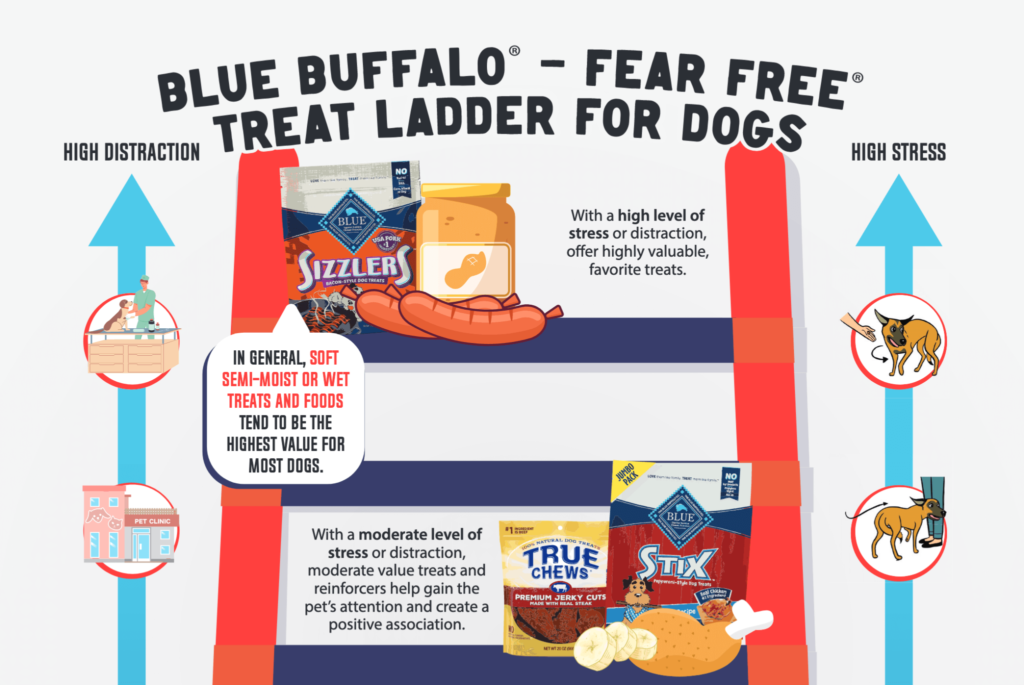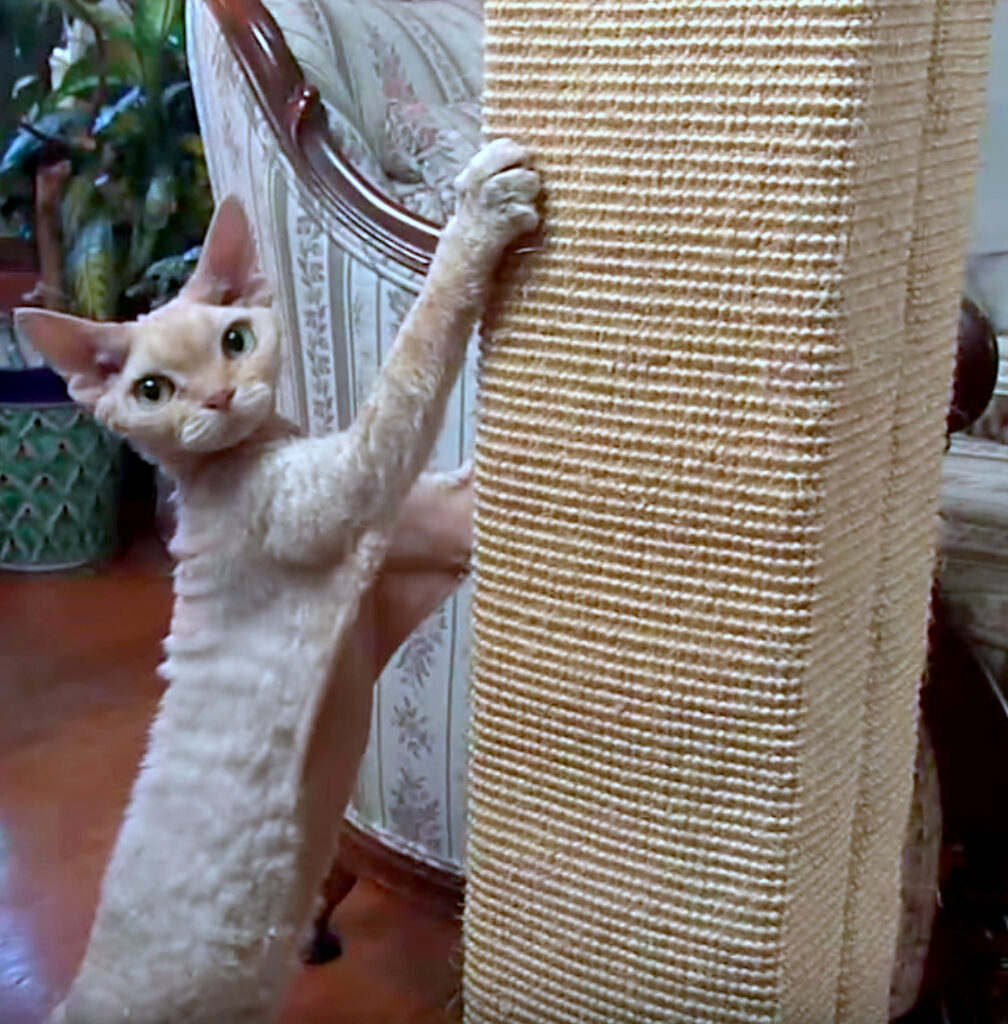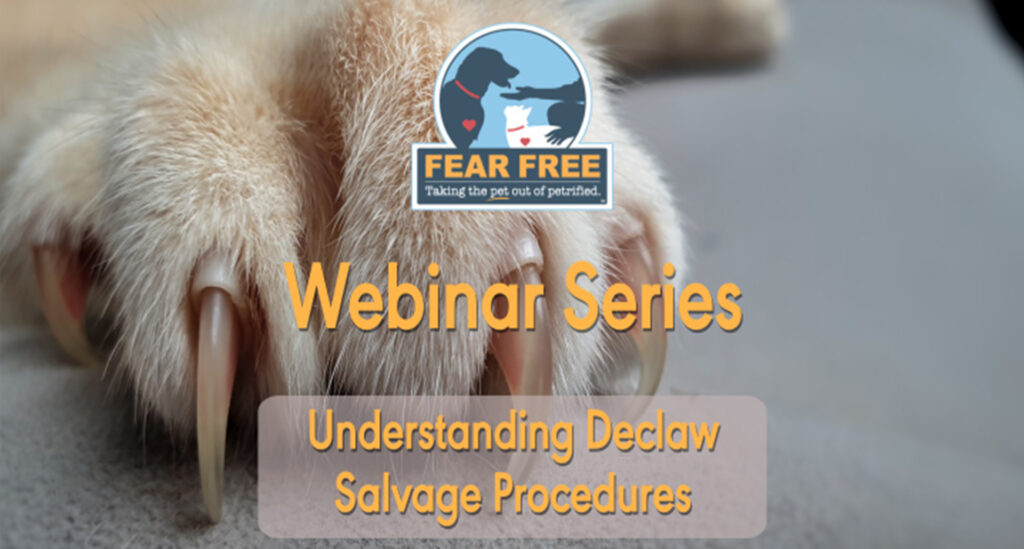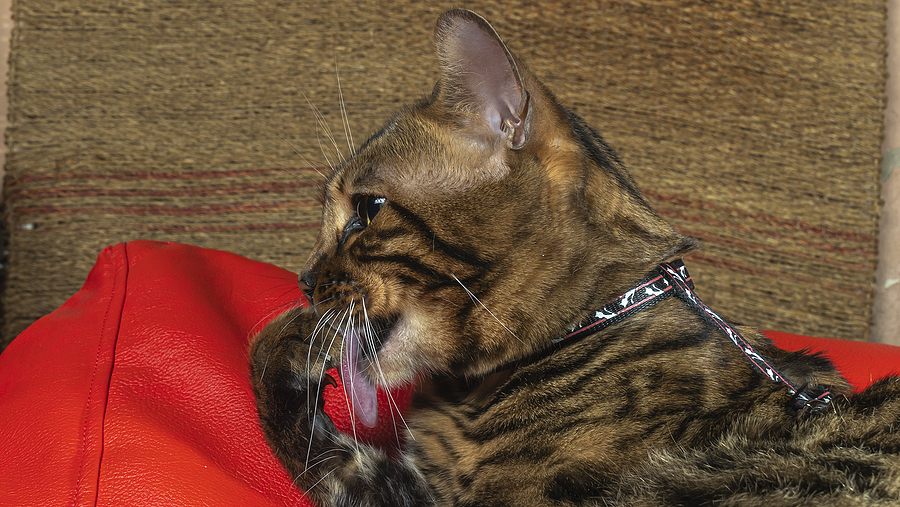Blog Archives

Download this handy treat ladder guide from Blue Buffalo and Fear Free.

Nail trims can be stressful for pets and owners alike. Set yourself and your pet up for success by downloading our nail trim handout!

For clients, seeing a pet in pain is the worst. Cats are especially adept at masking pain, so when they actually show they are in pain, they are really hurting. That’s where we were with Roxy.
Gabapentin had been prescribed, but all it did was increase her catnap time. I consulted an expert. “Let me hold Roxy’s paw and we’ll slowly increase the dosage,” said Robin Downing, DVM, internationally renowned for her knowledge about pain in pets.
Dr. Downing consulted with my Chicago, Illinois-based primary care practitioner Natalie Marks, DVM, who welcomed Dr. Downing’s contribution.
Downing gradually upped the dose of the gabapentin, and her persistent yet measured effort appeared to bring results without an accompanying significant primary side effect of the drug: drowsiness.
“Multimodal is the best approach for osteoarthritis for nearly all cats,” Downing says. To that end, we began to employ a tool called an Assisi Loop, which uses targeted pulsed electromagnetic field technology to treat pain and decrease inflammation. That not only benefited Roxy’s osteoarthritis, but also had the potential to aid her GI issues. In addition, for arthritis I give her injections of Adequan.
That was in 2018 and Roxy clearly benefited from the collaboration between Drs. Downing and Marks and the multimodal approach. However, about a year ago, I noted that Roxy appeared to be struggling a tad more and asked Dr. Marks for further advice.
“The struggle we have as small-animal practitioners is that we only have certain pain medications that are safe and approved for cats as they age, and many are contraindicated for cats with other conditions,” Marks said. “Our goal for our patients is for them to have the best quality of life and to be as pain free as possible every day. The beauty of veterinary medicine today is that we have a variety of integrative therapies which are readily available, and I thought about medical massage therapy. And technology can deliver a way to demonstrate options as never before.”
She suggested I contact Rosemary LoGiudice, DVM, who is boarded in veterinary rehabilitation medicine and practices in Hanover Park, Illinois. She is at least an hour from my home, not to mention this was all happening at the height of the pandemic.
Marks said, “I think this may be the perfect use of telehealth. And I believe massage therapy may help.” Dr. LoGiudice agreed.
LoGiudice noted that ideally she would want to get her hands on Roxy to feel her flexibility and for heat in the joints. But she was able to communicate with Dr. Marks, who has known Roxy most of her life and had recently examined her.
Using my phone, I took video of Roxy moving in her own element from different angles as directed by LoGiudice, who says, “When I can see the dog, cat, or horse moving in a natural way, I can get a good feel for stride and how the joints are moving. Very few dogs and cats are going to show me in the exam room how they move at home.”
LoGiudice and I jumped on a Zoom show and tell call. Dr. LoGiudice held a plush dog in her lap. She showed me exactly what to do, where to do it and how much pressure to exert when offering massage therapy. Old-school written directions could never replicate Dr. LoGiudice demonstrating, and then watching me and directing me, “Move your hand slightly lower.”
I gradually spent more time every night massaging Roxy. Roxy not only didn’t fend off the nightly spa treatment, she began to request it. Even now, a year later, when I stop, she paws at my face demanding more.
That was no surprise to Downing. “If this was causing Roxy pain or discomfort, or Roxy didn’t enjoy it, she still moves well enough to walk away,” she says.
Watching video of Roxy two weeks after the start of the Dale Spa treatment, LoGiudice wasn’t surprised either by the effect of medical massage to slightly but noticeably increase Roxy’s mobility and interest in exploring or moving to whatever room my wife and I are in. Also, LoGiudice is now inspired by the idea of using video and video chat to support clients in a way she hadn’t previously considered.
Downing agreed. “There’s no substitute for being hands-on with our patients, and for office visits, but you can certainly observe more remotely than what is possible in an exam room. And to schedule time for a virtual lesson in medical massage therapy, acupressure techniques, or teaching animals how to stretch are only a few examples.”
From her perspective of having known Roxy for more than half her life, Dr. Marks says, “I absolutely saw a difference in Roxy. What I really loved about this collaboration isn’t only about considering integrative care, it’s about how veterinarians are being creative to help all involved, especially at this time. And right now, we do need to be creative. I hope this specific type of partnership and using technology in the way we did with Roxy becomes a model, sticking around long after the pandemic.”
This article was reviewed/edited by board-certified veterinary behaviorist Dr. Kenneth Martin and/or veterinary technician specialist in behavior Debbie Martin, LVT.
Steve Dale, CABC (certified animal behavior consultant), hosts two national pet radio shows and is on WGN Radio, Chicago. He’s a regular contributor/columnist for many publications, including CATSTER, Veterinary Practice News, and the Journal of the National Association of Veterinary Technicians in America. He’s appeared on dozens of TV shows, including Oprah, many Animal Planet Programs, and National Geographic Explorer. He has contributed to or authored many pet books and veterinary textbooks such as “The Cat: Clinical Medicine and Management” and co-edited Decoding Your Dog, by the American College of Veterinary Behaviorists. He speaks at conferences around the world. www.stevedale.tv.

Understanding Declaw Salvage Procedures
Until declaws are eliminated in the United States, you will most likely encounter declawed patients in your practice. With recent advancements in surgery, salvage procedures can help manage pain and improve limb function. Join one of the leading figures in declaw salvage surgery Nicole Martell-Moran, DVM, MPH, DABVP (Feline Practice), to learn about the procedures involved, how to find training, and how you can incorporate it into your practice.

Helping New Pet Owners Create a Fear-Free & Happy Life for Their Pet
New pet owners can be overwhelmed with all the information we want to provide them regarding the health and wellbeing of their pet. However, if a strong human-animal relationship built on trust and empathy is not established, the pet very well may not remain in the home. In this webinar, Kenneth M. Martin, DVM, DACVB, and Debbie Martin, CPDT-KA, KPA CTP, LVT, VTS (Behavior), will provide you with 5 tips to give new pet owners so they can start the relationship off on the right paw, facilitate a strong bond, and keep pets in the home and coming back to your veterinary clinic.
Brought to you by Vetoquinol

According to feline behaviorists, neither age and nor gender are mitigating factors in compulsive behavior. However, wool sucking along with repetitive meowing has been found to be more common among so-called oriental breeds such as Siamese and Birman cats.
Dr. Nicholas Dodman, president and CEO of the Center for Canine Behavior Studies (they study feline behaviors too), who authored The Cat Who Cried for Help: Attitudes, Emotions, and the Psychology of Cats, ranks excessive grooming, known as psychogenic alopecia, as the most common abnormal repetitive behavior among cats generally. Wool-sucking and pica, the ingesting of weird objects, come in second, and, lastly, Dodman says that feline hyperesthesia, often referred to as twitchy skin syndrome, which results in a cat launching unprovoked attacks or suddenly appearing startled and then dashing away, is often also considered to be a compulsive disorder.
Psychogenic Alopecia
Cats are often mislabeled as independent, selfish, and uncaring creatures. In fact, the opposite applies; they are very caring and empathic and very conscious of their surroundings. Thus, all kinds of changes and conflict in their lives can evoke stress and anxiety. One common reaction to their personal situation is over-grooming.
“Feline psychogenic alopecia may begin as a displacement behavior arising from situations of conflict, frustration, or anxiety, but might in time become compulsive,” says Dodman. In an article published on the CCBS website, he spells it out: “The diagnosis of psychogenic alopecia as a compulsive disorder is reserved for those cases in which no underlying medical problem is evident.
“In most cats, over-grooming resulting in alopecia where they have pulled out chunks of fur and licked their skin raw, has an underlying skin disorder such as an allergic reaction to fleas or other external parasites. Inhalant allergies and even food allergies could be the root cause, and it’s important to seek veterinary assistance to rule all these causes out before the excessive grooming can be diagnosed as behavioral.”
In her book Cat vs Cat, Pam Johnson-Bennett says: “Because cats are such meticulous groomers, a cat parent may assume that the behavior is nothing unusual. Displacement grooming is a normal way for cats to recue their anxiety and calm themselves during or after a stressful situation. You may see this after a cat miscalculates a jump and falls to the floor. Although it may look as if she is embarrassed, it has more to do with her need to get her bearings because she was caught off-guard. Also being denied something she wants like getting on a counter and being repeatedly removed and even scolded can prompt displacement grooming,” she explains.
However, Johnson-Bennett points out that it’s easy to dismiss these small stressors. So, they build and suddenly the cat has huge bald patches!
“Interactive play comes to the rescue yet again,” she writes. “Use it to boost confidence and release endorphins. Pouncing and play games offer mental and physical stimulation.” And she warns, “if you see your cat sitting in a particular position before she’s about to start compulsively grooming, get out the wand and other toys and play instead!”
But play may not be the complete answer. Sometimes medication is necessary to help break the cycle.
Wool Sucking and Pica
Cats who love to chew on a blanket or a piece of cloth may be likened to young children who walk around sucking on pacifiers or hugging security blankets. This behavior often occurs in kittens who have been removed from their mothers too young and have not had the opportunity to nurse until their mothers properly weaned them. Soft, cuddly fabrics become a substitute for mama cat.
The sucking itself is not a problem, but if the sucking turns into chewing and swallowing, it can lead to problems such as gastrointestinal obstructions. Boredom and loneliness, especially when cats are left alone all day, can lead to separation anxiety and can prompt them to turn to material sucking and chewing to soothe themselves. This can lead to pica, the ingestion of material, plastic, and other non-food items.
Often the urge to suck on fabrics subsides as a kitten becomes an adult. However, problematic chewing can recur in adulthood as a defense mechanism for dealing with a stressful situation such as household tensions between cats or separation anxiety.
In the case study on compulsive wool sucking published in the Journal of Veterinary Behavior with which Dodman was involved, two hundred and four Siamese and Birman cats enrolled in the study were tracked for various physical characteristics, current and previous medical conditions, presence of an abnormally intense appetite, and environmental factors. The research ultimately showed that early weaning and small litter size were associated with increased risk of wool-sucking in Birmans only. The presence of a medical condition was associated with increased risk of wool-sucking in Siamese cats. The presence of an abnormally intense appetite was seen in all affected cats. However, no relationship was found between physical characteristics and wool-sucking in Siamese or Birman cats.
Dodman also points out that medical conditions that can trigger abnormal ingestion of inappropriate material include hunger, nutritional deficiencies such as anemia or inadequate dietary fiber, diabetes, or tumors.
Feline Hyperesthesia
“This is a complicated behavioral condition with some features that appear compulsive and others that appear frankly neurological,” says Dodman. “Because of the overlap between symptoms of other issues, it is thought to possibly be a form of partial seizures with compulsive components. There is an apparent sensitivity to touch (episodes may be induced by stroking along the spine), which can trigger attacks and accounts for the name of this syndrome,” he further explains.
Feline hyperesthesia is often referred to as rippling skin syndrome, rolling skin syndrome, or twitchy skin syndrome. Signs include dilation of pupils, excessive skin rippling, and frenetic self-directed grooming that may result in hair loss. Grooming may be so intense it may manifest as self-directed aggression often focused on the tail (tail-chasing).
Affected cats may emit excessive and unusual vocalizations and appear to hallucinate (act afraid of their tail) and run away. They may appear “manic” (excited look, frantic running, jumping) and are frequently extremely sensitive to touch. Sometimes aggressive bouts are preceded by attention-seeking and enhanced affection to people. Affected cats are often anxious and restless, constantly wandering and pacing. Sometimes the aggression can be directed at people.
“Almost all aggressive behavior can be traced back to a specific cause. Idiopathic aggression – the name given to totally unprovoked aggression that has no known cause — is rare,” says Johnson-Bennett. “This type of aggression is too difficult and too dangerous for a cat parent to try and correct without professional help.”
Helping Owners
Advise cat parents to be on the lookout for excessive sucking or chewing on fabrics, behaviors such as hunting and pouncing at unseen prey, running and chasing, paw shaking, freezing, excessive vocalization and a manic look, self-directed aggression such as tail chasing, and overgrooming to the point of pulling out fur in patches. While these may start out as signs of conflict or anxiety, if not attended to, they can become compulsive disorders over time.
Ask cat parents about conflicts in the home and whether there are ways to eliminate it. They may need a referral to a veterinary behavior specialist who can help them to recognize and manage such conflicts, whether they are between cats and humans, cats and other cats, or cats and other animals in the home. Other things to try:
- Environment enrichment may help to distract a cat from compulsive behavior.
- A tall cat tree or cat condo strategically placed near a window helps keep cats engaged.
- A fountain not only attracts a cat to drink water but also adds sound and motion enhancements to the environment.
- Offer the cat an indoor garden of safe plants to nibble on, ideally placed near a water fountain or water dish.
- Wand toys allow cats to chase, pounce, and play.
- For cats who enjoy exploring, leash-training can provide safe outdoor excursions. A catio is another option that can provide distractions from self-harming.
- Suggest puzzles that can be filled with treats or a portion of a meal.
- If wool sucking or over-grooming are involved, a diet that includes a high-fiber kibble may help redirect the cat from compulsive behaviors to focus on nibbling. A veterinary nutritionist may have suggestions.
This article was reviewed/edited by board-certified veterinary behaviorist Dr. Kenneth Martin and/or veterinary technician specialist in behavior Debbie Martin, LVT.
Sandy Robins is an award-winning pet lifestyle journalist and author of For the Love of Cats, Fabulous Felines: Health and Beauty Secrets for the Pampered Cat, The Original Cat Bible, and Making the Most of All Nine Lives: The Extraordinary Life of Buffy The Cat.

The “fear center” and the “pain center” occupy adjacent areas of the brain. The thalamus is the area of the brain that registers pain, and on either side of the thalamus is the limbic system, which is responsible for emotions including fear, anxiety, and the sequelae of stress (FAS).
These two areas of the brain “talk” to each other and send signals back and forth. The thalamus sending signals to the limbic system is what causes your reaction to hitting your finger with a hammer. When this thalamic-limbic crosstalk happens in an animal in acute pain, the animal may lash out at the owner or veterinary staff.
So now consider an animal who is in pain and has been presented to you. If experiencing acute pain, the animal may lash out due to a combination of pain and FAS. If experiencing chronic pain, many of these pets act dull and disinterested. The owner may even comment that the pet just doesn’t socialize and lacks the energy and mobility that she used to demonstrate. Even worse is the animal who has chronic pain, say from osteoarthritis, and now has an acute injury on top of it. The distress in some of these animals is almost too much to bear.
It is easy for us to recognize and treat acute pain, but the diagnosis of chronic pain states can be difficult for a variety of reasons. It takes time to take a thorough history and perform a complete pain exam on dogs and cats. However, there are many resources available to make that task easier, including pet owner-friendly screening checklists for osteoarthritis (Cat, Dog) and expert tips for the OA exam (feline OA exam).
Even with successful diagnosis, the treatment of chronic pain can sometimes be difficult especially if your treatment is narrow in focus. But it is essential to make a timely diagnosis of chronic pain and provide effective analgesia to be successful in therapy. And it is also important that the owner understands your diagnosis, whether through education alone or with the help of radiographs and teaching tools (feline and canine chronic pain). The owner is an essential member of the pain treatment team, both in the evaluation of treatments over time but also in enlisting them in the day to day therapies that might be required.
My approach to the treatment of chronic pain in dogs, for example, is to build a pyramid of treatments, and on the base layer I start with an NSAID. The NSAID I use most commonly is Rimadyl® (carprofen), which I really like for its effects on both pain and inflammation. For many chronic OA cases, there are other factors that can influence the ability to manage both pain and disease progression, and they should all be looked at.
For example, consider the animal next. Is he overweight? One study showed that in an obese dog, losing only about 10 percent of body weight can significantly improve lameness1. In other words, weight loss for an overweight dog can amplify the pain relief achieved with an NSAID alone
What about exercise? Again, one human study showed that one-half hour of exercise 5 days a week for people with knee OA was the equivalent of – you guessed it: an NSAID! So now you have tripled your pain-relieving efforts by building a solid foundation of multi-modal therapies, upon which you can add other therapies as needed.
It is beyond the scope of this writing to discuss all possible treatments: medications, physical therapy, acupuncture, and so forth, but I encourage everyone to read or re-read the 2015 AAHA Pain Management Guidelines for a thorough review of all of the pain management options we have for both acute and chronic pain.
What does the future hold for us? The most exciting thing I have seen on the horizon is the introduction of anti-NGF monoclonal antibodies. NGF, or Nerve Growth Factor, is one of several major “players” in the transmission of pain via the nociceptors. The use of these monoclonal antibodies holds great promise to reduce the sensation of pain in our patients with osteoarthritis. More information about the action of anti-NGF monoclonal antibodies can be found at the New Science of OA Pain website.
IMPORTANT SAFETY INFORMATION FOR RIMADYL: As a class, NSAIDs may be associated with gastrointestinal, kidney and liver side effects. These are usually mild but may be serious. Pet owners should discontinue therapy and contact their veterinarian immediately if side effects occur. Evaluation for pre-existing conditions and regular monitoring are recommended for pets on any medication, including Rimadyl. Use with other NSAIDs or corticosteroids should be avoided.
See full Prescribing Information at:
https://www2.zoetisus.com/content/_assets/docs/Petcare/rimadyl-prescribing-information.pdf
Reference:
- Marshall WG, Hazewinkel HA, Mullen D, et al. The effect of weight loss on lameness in obese dogs with osteoarthritis. Vet Res Commun 2010;34(3):241–53.
This article was reviewed/edited by board-certified veterinary behaviorist Dr. Kenneth Martin and/or veterinary technician specialist in behavior Debbie Martin, LVT.![]() Sponsored by our friends at Zoetis Petcare. ©2021 Zoetis Services LLC. All rights reserved RIM-00324
Sponsored by our friends at Zoetis Petcare. ©2021 Zoetis Services LLC. All rights reserved RIM-00324

These battered bonds are often related to behavior problems such as destruction to the home, inappropriate elimination, and aggression. In a 2013 study by Jennifer Y. Kwan and Melissa Bain, 65 percent of owners relinquished pets for behavior reasons. This study also supported the use of positive reinforcement, finding that use of punishment-based methods resulted in less satisfaction with a pet’s behavior, which can be damaging to the bond.1
The word “repair” means to restore by replacing a part or putting together what is torn or broken or to restore to a sound or healthy state. How can we repair a nearly broken human-animal bond? The role of a veterinary technician or assistant can be crucial in mending and strengthening this bond.
A skilled veterinary behavior professional should be able to demonstrate the prescribed behavioral therapy plans, coach the client through them, and be flexible with both pet and owner learning styles.2 In my practice, I describe my role as “case manager”: the person with whom each client is in contact with most frequently. It is my job to relay information clearly and effectively to the veterinarian and be sure that the entire behavior team (veterinarian, trainer, and owner) are working toward the common goal of restoring the bond.
Counseling aspects of behavioral medicine and marriage/family therapy have many commonalities.3 One of the most profound similarities is how change occurs in the context of treatment. In behavior medicine, our clients may come in with negative thoughts, anger, and fears associated with their pet. The veterinary technician or assistant’s role in the behavior team is to change the emotional experience of the pet along with that of the pet owner. When a family walks into our practice and their pet has been displaying owner-related aggression, my first questions are the following:
- How are you feeling about your pet?
- Do you feel safe in your home?
- What is your current relationship with the pet?
The client needs to express their concerns if treatment is going to be attempted. Behavioral therapy is essential, but the context and triggers of the problem are less important until people can form a more positive association with the pet. After the veterinarian discusses the behavioral diagnosis, I typically break down the information in a more down to earth fashion so the entire family can understand the mental concerns their pet has developed. In this way, the family can begin to relate to the pet and see things through their eyes, and this can jump-start the process of rebuilding the bond.
A second similarity to human-based therapy is the difficulties and barriers associated with clients.4 Most of our clients walk into the consultation room and expect to be told they did something wrong. They may be defensive, anxious, and closed off, reluctant to give a detailed behavioral history, which can impact treatment.
Sometimes clients are fearful about sharing a pet’s aggressive behaviors because they do not want to euthanize their pet. They feel as if they will be judged and forced to make an unwanted decision. One of my strongest skills as a behavior team member is gaining the trust of clients and building a strong rapport early on. I want each client and pet to have a wonderful experience with our clinic, but I also want to have a strong connection with that client, share empathy, and understand each issue from their perspective.
Clients may be at the end of their rope, but usually there is an inch of that rope left to work with. I think of the rope as the bond between owner and pet. Hang on to that tiny piece as it is still technically intact! Each client walks into the practice for a reason even if there is only a tiny strand of the bond remaining. If you can open them up, connect, and gain their trust, you can begin to reshape the negativity they feel toward their pet and repair the relationship.
One of the most important terms when repairing the human-animal bond is “empathy,” the ability to have a deep emotional understanding of another’s feelings and experiences.5 For veterinary behavior team members, this ability is crucial for success with any client or patient. They should be able to identify and empathize with the fear and anxiety the pet and client may be experiencing. This is the first step in modifying the behavior of both. Psychologist Marshall Rosenberg stated it best: “When we understand the needs that motivate ourselves and others’ behaviors, we have no enemies.” 6
I think this is important to recognize when working to rebuild or strengthen a human-animal bond. It is important for the client and veterinary behavior team to see things from the pet’s perspective. The client can then learn that the pet is not their enemy. The pet is not performing these behaviors to spite them. The pet is fearful, stressed, or anxious and may be trying to keep themselves safe. Being able to take a walk in someone else’s shoes, or paws, is a vital step in deepening the human-animal bond.
Mending the human-animal bond is not an easy task. It takes the expertise of a strong, educated, and skilled veterinary behavior team to even begin to reunite and mend the connection between client and pet. When working in a general practice, any sign that the human-animal bond is deteriorating between a client and patient should be brought to the team’s attention so the veterinarian can make a referral to a veterinary behavior practice.
As veterinary team members, we all want to save the lives of pets. This begins with keeping a strong bond between client and pet. Giving appropriate, science-based recommendations on training and behavioral therapy can be the first step in this process, starting with puppy and kitten visits. If we all work toward a common goal, we can make a difference.
References:
- Kwan Y. Jennifer, Bain J. Melissa. Owner Attachment and Problem Behaviors Related to Relinquishment and Training Techniques of Dogs. Journal of Applied Animal Welfare Science. 2013; 168-183. https://doi.org/10.1080/10888705.2013.768923
2-6. Shaw K. Julie, Martin Debbie. Canine and Feline Behavior for Veterinary Technicians and Nurses. 1st edition. John Wiley; 2015.
This article was reviewed/edited by board-certified veterinary behaviorist Dr. Kenneth Martin and/or veterinary technician specialist in behavior Debbie Martin, LVT.

